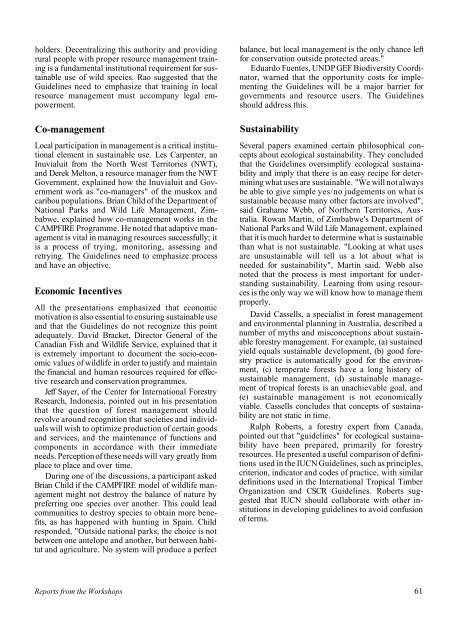Buenos Aires, Argentina - IUCN
Buenos Aires, Argentina - IUCN
Buenos Aires, Argentina - IUCN
Create successful ePaper yourself
Turn your PDF publications into a flip-book with our unique Google optimized e-Paper software.
holders. Decentralizing this authority and providing<br />
rural people with proper resource management training<br />
is a fundamental institutional requirement for sustainable<br />
use of wild species. Rao suggested that the<br />
Guidelines need to emphasize that training in local<br />
resource management must accompany legal empowerment.<br />
Co-management<br />
Local participation in management is a critical institutional<br />
element in sustainable use. Les Carpenter, an<br />
Inuvialuit from the North West Territories (NWT),<br />
and Derek Melton, a resource manager from the NWT<br />
Government, explained how the Inuvialuit and Government<br />
work as "co-managers" of the muskox and<br />
caribou populations. Brian Child of the Department of<br />
National Parks and Wild Life Management, Zimbabwe,<br />
explained how co-management works in the<br />
CAMPFIRE Programme. He noted that adaptive management<br />
is vital in managing resources successfully; it<br />
is a process of trying, monitoring, assessing and<br />
retrying. The Guidelines need to emphasize process<br />
and have an objective.<br />
Economic Incentives<br />
All the presentations emphasized that economic<br />
motivation is also essential to ensuring sustainable use<br />
and that the Guidelines do not recognize this point<br />
adequately. David Bracket, Director General of the<br />
Canadian Fish and Wildlife Service, explained that it<br />
is extremely important to document the socio-economic<br />
values of wildlife in order to justify and maintain<br />
the financial and human resources required for effective<br />
research and conservation programmes.<br />
Jeff Sayer, of the Center for International Forestry<br />
Research, Indonesia, pointed out in his presentation<br />
that the question of forest management should<br />
revolve around recognition that societies and individuals<br />
will wish to optimize production of certain goods<br />
and services, and the maintenance of functions and<br />
components in accordance with their immediate<br />
needs. Perception of these needs will vary greatly from<br />
place to place and over time.<br />
During one of the discussions, a participant asked<br />
Brian Child if the CAMPFIRE model of wildlife management<br />
might not destroy the balance of nature by<br />
preferring one species over another. This could lead<br />
communities to destroy species to obtain more benefits,<br />
as has happened with hunting in Spain. Child<br />
responded, "Outside national parks, the choice is not<br />
between one antelope and another, but between habitat<br />
and agriculture. No system will produce a perfect<br />
balance, but local management is the only chance left<br />
for conservation outside protected areas."<br />
Eduardo Fuentes, UNDP GEF Biodiversity Coordinator,<br />
warned that the opportunity costs for implementing<br />
the Guidelines will be a major barrier for<br />
governments and resource users. The Guidelines<br />
should address this.<br />
Sustainability<br />
Several papers examined certain philosophical concepts<br />
about ecological sustainability. They concluded<br />
that the Guidelines oversimplify ecological sustainability<br />
and imply that there is an easy recipe for determining<br />
what uses are sustainable. "We will not always<br />
be able to give simple yes/no judgements on what is<br />
sustainable because many other factors are involved",<br />
said Grahame Webb, of Northern Territories, Australia.<br />
Rowan Martin, of Zimbabwe's Department of<br />
National Parks and Wild Life Management, explained<br />
that it is much harder to determine what is sustainable<br />
than what is not sustainable. "Looking at what uses<br />
are unsustainable will tell us a lot about what is<br />
needed for sustainability", Martin said. Webb also<br />
noted that the process is most important for understanding<br />
sustainability. Learning from using resources<br />
is the only way we will know how to manage them<br />
properly.<br />
David Cassells, a specialist in forest management<br />
and environmental planning in Australia, described a<br />
number of myths and misconceptions about sustainable<br />
forestry management. For example, (a) sustained<br />
yield equals sustainable development, (b) good forestry<br />
practice is automatically good for the environment,<br />
(c) temperate forests have a long history of<br />
sustainable management, (d) sustainable management<br />
of tropical forests is an unachievable goal, and<br />
(e) sustainable management is not economically<br />
viable. Cassells concludes that concepts of sustainability<br />
are not static in time.<br />
Ralph Roberts, a forestry expert from Canada,<br />
pointed out that "guidelines" for ecological sustainability<br />
have been prepared, primarily for forestry<br />
resources. He presented a useful comparison of definitions<br />
used in the <strong>IUCN</strong> Guidelines, such as principles,<br />
criterion, indicator and codes of practice, with similar<br />
definitions used in the International Tropical Timber<br />
Organization and CSCR Guidelines. Roberts suggested<br />
that <strong>IUCN</strong> should collaborate with other institutions<br />
in developing guidelines to avoid confusion<br />
of terms.<br />
Reports from the Workshops 61












